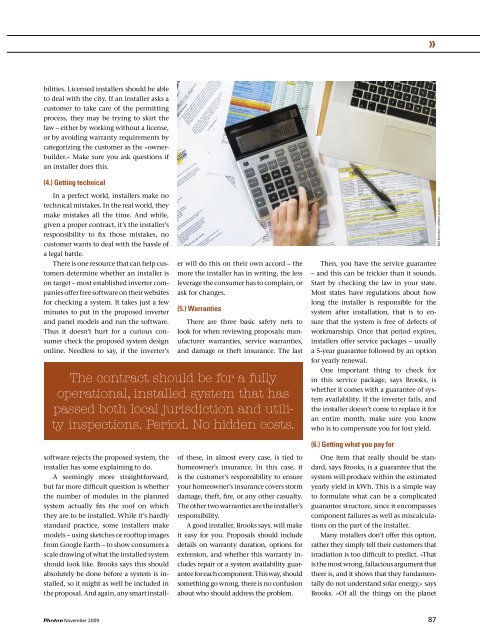INTRODUCTORY SPECIAL INTRODUCTORY ... - PHOTON Info
INTRODUCTORY SPECIAL INTRODUCTORY ... - PHOTON Info
INTRODUCTORY SPECIAL INTRODUCTORY ... - PHOTON Info
Create successful ePaper yourself
Turn your PDF publications into a flip-book with our unique Google optimized e-Paper software.
ilities. Licensed installers should be able<br />
to deal with the city. If an installer asks a<br />
customer to take care of the permitting<br />
process, they may be trying to skirt the<br />
law – either by working without a license,<br />
or by avoiding warranty requirements by<br />
categorizing the customer as the »owner-<br />
builder.« Make sure you ask questions if<br />
an installer does this.<br />
(4.) Getting technical<br />
In a perfect world, installers make no<br />
technical mistakes. In the real world, they<br />
make mistakes all the time. And while,<br />
given a proper contract, it’s the installer’s<br />
responsibility to fix those mistakes, no<br />
customer wants to deal with the hassle of<br />
a legal battle.<br />
There is one resource that can help cus-<br />
tomers determine whether an installer is<br />
on target – most established inverter com-<br />
panies offer free software on their websites<br />
for checking a system. It takes just a few<br />
minutes to put in the proposed inverter<br />
and panel models and run the software.<br />
Thus it doesn’t hurt for a curious con-<br />
sumer check the proposed system design<br />
online. Needless to say, if the inverter’s<br />
software rejects the proposed system, the<br />
installer has some explaining to do.<br />
A seemingly more straightforward,<br />
but far more difficult question is whether<br />
the number of modules in the planned<br />
system actually fits the roof on which<br />
they are to be installed. While it’s hardly<br />
standard practice, some installers make<br />
models – using sketches or rooftop images<br />
from Google Earth – to show consumers a<br />
scale drawing of what the installed system<br />
should look like. Brooks says this should<br />
absolutely be done before a system is in-<br />
stalled, so it might as well be included in<br />
the proposal. And again, any smart install-<br />
er will do this on their own accord – the<br />
more the installer has in writing, the less<br />
leverage the consumer has to complain, or<br />
ask for changes.<br />
(5.) Warranties<br />
There are three basic safety nets to<br />
look for when reviewing proposals: man-<br />
ufacturer warranties, service warranties,<br />
and damage or theft insurance. The last<br />
The contract should be for a fully<br />
operational, installed system that has<br />
passed both local jurisdiction and utility<br />
inspections. Period. No hidden costs.<br />
of these, in almost every case, is tied to<br />
homeowner’s insurance. In this case, it<br />
is the customer’s responsibility to ensure<br />
your homeowner’s insurance covers storm<br />
damage, theft, fire, or any other casualty.<br />
The other two warranties are the installer’s<br />
responsibility.<br />
A good installer, Brooks says, will make<br />
it easy for you. Proposals should include<br />
details on warranty duration, options for<br />
extension, and whether this warranty in-<br />
cludes repair or a system availability guar-<br />
antee for each component. This way, should<br />
something go wrong, there is no confusion<br />
about who should address the problem.<br />
November 2009 87<br />
»<br />
Then, you have the service guarantee<br />
– and this can be trickier than it sounds.<br />
Start by checking the law in your state.<br />
Most states have regulations about how<br />
long the installer is responsible for the<br />
system after installation, that is to en-<br />
sure that the system is free of defects of<br />
workmanship. Once that period expires,<br />
installers offer service packages – usually<br />
a 5-year guarantee followed by an option<br />
for yearly renewal.<br />
One important thing to check for<br />
in this service package, says Brooks, is<br />
whether it comes with a guarantee of sys-<br />
tem availability. If the inverter fails, and<br />
the installer doesn’t come to replace it for<br />
an entire month, make sure you know<br />
who is to compensate you for lost yield.<br />
(6.) Getting what you pay for<br />
One item that really should be stan-<br />
dard, says Brooks, is a guarantee that the<br />
system will produce within the estimated<br />
yearly yield in kWh. This is a simple way<br />
to formulate what can be a complicated<br />
guarantee structure, since it encompasses<br />
component failures as well as miscalcula-<br />
tions on the part of the installer.<br />
Many installers don’t offer this option,<br />
rather they simply tell their customers that<br />
irradiation is too difficult to predict. »That<br />
is the most wrong, fallacious argument that<br />
there is, and it shows that they fundamen-<br />
tally do not understand solar energy,« says<br />
Brooks. »Of all the things on the planet<br />
Rolf Schulten / photon-pictures.com

















